
 |
Tea Clipper |
 |
| from TeaAntiques.com | ||
| Edition One Hundred and Five |
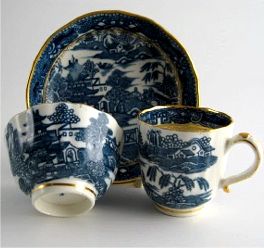
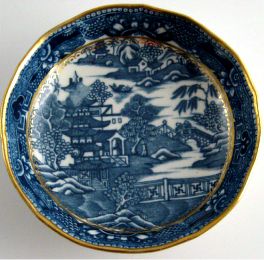 An
attractive tea bowl, coffee can and saucer, printed with a delightful blue oriental
scene of a pagoda in a charming landscape with houses, trees, boat and a bridge
with two figures crossing it. This beautiful tea bowl and saucer was made at the
famous Caughley factory, c1785.
An
attractive tea bowl, coffee can and saucer, printed with a delightful blue oriental
scene of a pagoda in a charming landscape with houses, trees, boat and a bridge
with two figures crossing it. This beautiful tea bowl and saucer was made at the
famous Caughley factory, c1785.
The tea bowl and coffee can are marked with the Caughley 'Salopian' underglaze blue 'S' mark the saucer has the same mark but with an 'O' next to the 'S'. These marks were used at the Caughley factory between 1775-90. The marks are very clearly painted in the centre of the under side of the tea bowl, coffee can and saucer.
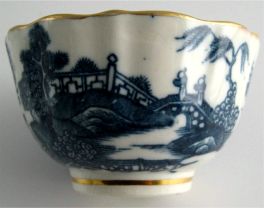
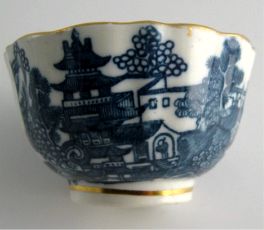
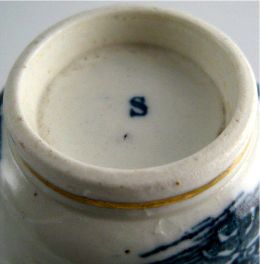
A delightful Caughley trio dating from c1785. A fine addition for the collector of fine quality Caughley porcelain from the eighteenth century.
More details of this item and other tea related antiques can be found by visiting my web site at www.TeaAntiques.com.
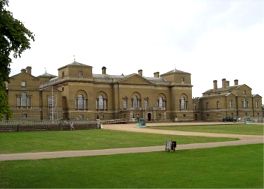 The
creation of Thomas Coke, Earl of Leicester, Holkham is a magnificent Eighteenth
century mansion situated close to the north Norfolk coast. The rather restrained,
but beautifully proportioned Palladian façade rather belies the extravagant interior.
The
creation of Thomas Coke, Earl of Leicester, Holkham is a magnificent Eighteenth
century mansion situated close to the north Norfolk coast. The rather restrained,
but beautifully proportioned Palladian façade rather belies the extravagant interior.
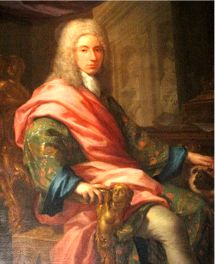 Thomas
Coke, like so many aristocrats, had been on the Grand Tour of Europe. He had a fascination
for architecture and studied it during his time in Rome. It was highly likely that
this then influenced the design for his new house at Holkham. During his tour he
had amassed a vast collection of books, statues, paintings and furniture, far too
much and too grand to display in his existing manor house at Holkham. Thus plans
were drawn up by William Kent for Holkham house and which included designs for the
interior of the family wing. taking more than 30 years to build, the house was finally
completed in 1764, sadly five years after the death of Thomas Coke.
Thomas
Coke, like so many aristocrats, had been on the Grand Tour of Europe. He had a fascination
for architecture and studied it during his time in Rome. It was highly likely that
this then influenced the design for his new house at Holkham. During his tour he
had amassed a vast collection of books, statues, paintings and furniture, far too
much and too grand to display in his existing manor house at Holkham. Thus plans
were drawn up by William Kent for Holkham house and which included designs for the
interior of the family wing. taking more than 30 years to build, the house was finally
completed in 1764, sadly five years after the death of Thomas Coke.
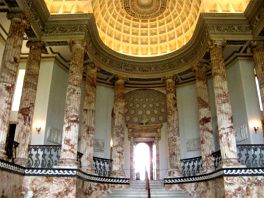 Passing
through the front door leads into the Marble Hall, which is breathtakingly magnificent.
Monumental in size and proportion, the hall a triumphal construction, mainly of
alabaster rather than marble. This was chosen as it has a softer and somewhat translucent
appearance more pleasing to the eye. In front of you as you enter is a stone flight
of steps taking you up to the piano nobile from which rises a stunning
set of ionic columns of alabaster between which are ornate iron railings. The columns
support a beautiful domed ceiling with an ornate frieze. Around the hall are fine
plaster copies of Roman and Greek Gods. Who could fail to be impressed by the masculine
stature of this magnificent hall?
Passing
through the front door leads into the Marble Hall, which is breathtakingly magnificent.
Monumental in size and proportion, the hall a triumphal construction, mainly of
alabaster rather than marble. This was chosen as it has a softer and somewhat translucent
appearance more pleasing to the eye. In front of you as you enter is a stone flight
of steps taking you up to the piano nobile from which rises a stunning
set of ionic columns of alabaster between which are ornate iron railings. The columns
support a beautiful domed ceiling with an ornate frieze. Around the hall are fine
plaster copies of Roman and Greek Gods. Who could fail to be impressed by the masculine
stature of this magnificent hall?
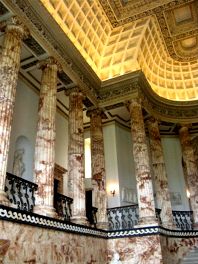
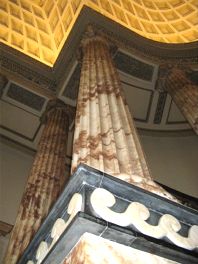
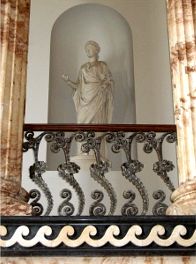
The Marble Hall is the central key in the main block of the house and is surrounded by the State Rooms. From each of the four corners of this main block emanate four separate side wings, these forming family and guest apartments which afford total privacy and independence from the more formal rooms.
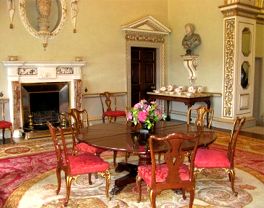 To
the right of the Marble Hall is the North Dining Room. Formed by a 27 foot cube,
like the hall, is of perfect proportion. There is a stone apse on one side with
a domed ceiling adapted from a design by Inigo Jones. At both ends of the room are
marble fireplaces inset with reliefs depicting scenes from Aesop's Fables. In the
centre of the room is a circular dining table with single central support, c1835.
This has an ingenious cranking mechanism for extending the table by inserting more
table leaves. Around the table and standing around the room are a set of dining
chairs with carved and parcel gilt backs and legs. The richly woven carpet is from
the French Savonnerie company, supplied to the house c1820. This carpet manufacturer
famously produced many carpets for the French Royal Family.
To
the right of the Marble Hall is the North Dining Room. Formed by a 27 foot cube,
like the hall, is of perfect proportion. There is a stone apse on one side with
a domed ceiling adapted from a design by Inigo Jones. At both ends of the room are
marble fireplaces inset with reliefs depicting scenes from Aesop's Fables. In the
centre of the room is a circular dining table with single central support, c1835.
This has an ingenious cranking mechanism for extending the table by inserting more
table leaves. Around the table and standing around the room are a set of dining
chairs with carved and parcel gilt backs and legs. The richly woven carpet is from
the French Savonnerie company, supplied to the house c1820. This carpet manufacturer
famously produced many carpets for the French Royal Family.
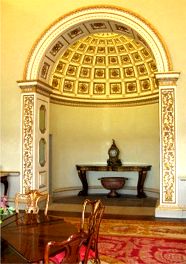
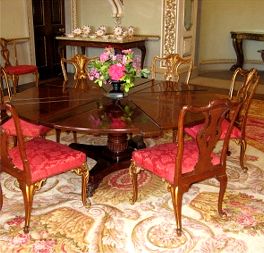
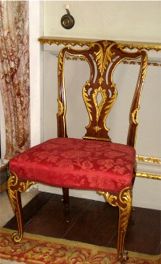
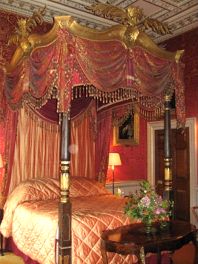
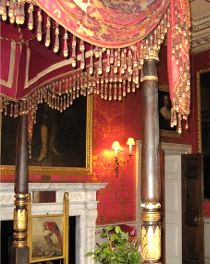 Continuing
through the Dining Room leads to the first of the four separate corner wings of
the house, this, the Strangers Wing; named as it was a wing for guests to stay in.
There are four bedrooms on this level and two further bedrooms on the floor above.
The bedroom open on the tour of the house is known as The Parrot Bedroom, taking
its name from a painting to the right of the lovely four poster bed. The painting
is by Frans Snyders and depicts exotic scarlet macaws and parrots.
Continuing
through the Dining Room leads to the first of the four separate corner wings of
the house, this, the Strangers Wing; named as it was a wing for guests to stay in.
There are four bedrooms on this level and two further bedrooms on the floor above.
The bedroom open on the tour of the house is known as The Parrot Bedroom, taking
its name from a painting to the right of the lovely four poster bed. The painting
is by Frans Snyders and depicts exotic scarlet macaws and parrots.
The Parrot Bedroom is decorated in a rich crimson wall and bed hangings, what a splendid room to give your guests in which to stay. Beyond the bedroom is a spacious, if a little dated but stylish en suite bathroom.
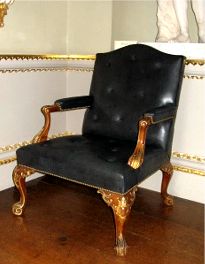 Returning
to the main block of the house, a long Statue gallery runs down one side of this
block to the next corner wing. The statues within apses down the gallery are of
ancient Gods and Goddesses, it also contains a set of William Kent armchairs upholstered
in blue leather. Smaller rooms at either end of the statue Gallery are the North
and South Tribunes which form a suite of three open rooms. Turning right at the
far end of the gallery leads to the Library Passage. Here hangs a painting by Sebastiano
Conca, entitled 'The vision of Aeneas in the Elysian Fields' in which Thomas Coke
is himself depicted in the guise of Orpheus.
Returning
to the main block of the house, a long Statue gallery runs down one side of this
block to the next corner wing. The statues within apses down the gallery are of
ancient Gods and Goddesses, it also contains a set of William Kent armchairs upholstered
in blue leather. Smaller rooms at either end of the statue Gallery are the North
and South Tribunes which form a suite of three open rooms. Turning right at the
far end of the gallery leads to the Library Passage. Here hangs a painting by Sebastiano
Conca, entitled 'The vision of Aeneas in the Elysian Fields' in which Thomas Coke
is himself depicted in the guise of Orpheus.
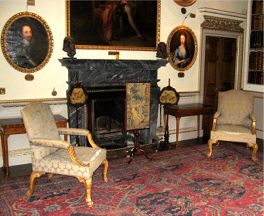 Moving
into the Libraries you are now in what was the Family Wing, here the Coke family
have lived since the 1740s. The arrangement of the rooms has changed in use to accommodate
prints and books from the attic in the early 19th century. The Classical Library,
the first of the rooms, is hung with a painting of 'Coke of Norfolk, 1st earl of
the 2nd creation of the Norfolk title.
Moving
into the Libraries you are now in what was the Family Wing, here the Coke family
have lived since the 1740s. The arrangement of the rooms has changed in use to accommodate
prints and books from the attic in the early 19th century. The Classical Library,
the first of the rooms, is hung with a painting of 'Coke of Norfolk, 1st earl of
the 2nd creation of the Norfolk title.
The second of the libraries is the Manuscript Library which used to serve as Thomas Coke's dressing room, the principle portrait in the room is of Thomas Coke, builder of the house. The portrait shows Thomas at the age of 20 when he was in Italy on The Grand Tour. In the background of the portrait are antique statues alluding to his keen interest in the arts and as a connoisseur collector.
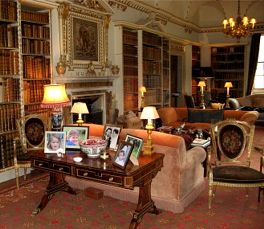 The
final room in the Family Wing is The Long Library and is much used by the present
family for entertaining guests. The comfortable room has fine built-in bookcases
lining the walls which contain a mass of leather-bound printed books. On furniture
around the room are framed photographs of the present family members. Above the
marble fireplace is a built-in ornate over mantle with a broken pediment at the
top enriched with gilt decoration. This frames a spectacular 1st century BC mosaic
of a Lion setting about a Leopard, and was brought back from Italy having originally
been in a Theatre in Gubbio; it was amongst the treasures brought back by Thomas
Coke from his Tour. A concealed door to the right of the fireplace houses the main
staircase of this wing which was also used by servants thus not disturbing people
in adjacent rooms.
The
final room in the Family Wing is The Long Library and is much used by the present
family for entertaining guests. The comfortable room has fine built-in bookcases
lining the walls which contain a mass of leather-bound printed books. On furniture
around the room are framed photographs of the present family members. Above the
marble fireplace is a built-in ornate over mantle with a broken pediment at the
top enriched with gilt decoration. This frames a spectacular 1st century BC mosaic
of a Lion setting about a Leopard, and was brought back from Italy having originally
been in a Theatre in Gubbio; it was amongst the treasures brought back by Thomas
Coke from his Tour. A concealed door to the right of the fireplace houses the main
staircase of this wing which was also used by servants thus not disturbing people
in adjacent rooms.
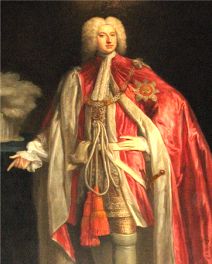
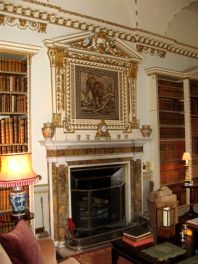
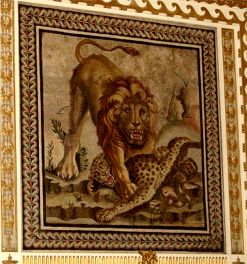
Retracing your steps back into the main block of the house takes you into the State Rooms along the South Front of the house. The first of these rooms is the Drawing Room, richly decorated in a large repeat pattern wall fabric. Of the many fine paintings in the room, those on the fireplace wall are the same paintings that are in the same location as they were in the 18th century. Above the carved white marble fireplace is a large painting of 'The Madonna in Glory' by Pietro de Pietri (1671-1716). The placing of this painting was deliberate; Thomas Coke had placed it above two marble busts on the fireplace, these of Caesar Marcus Aurelius and Emperor Caracalla thus symbolising the victory of Christianity over these heathens and their despicable deeds.
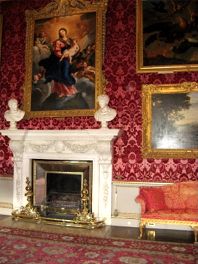
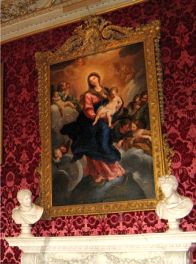
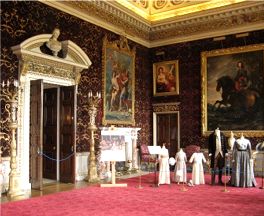
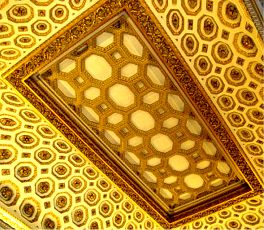 Passing
through the partially gilded hardwood door leads into the most impressive Saloon.
The decoration is of the same style and colour as The Drawing Room, but on a larger
and more impressive scale. In particular it has a beautiful vaulted 32-foot high
ceiling decorated with large gilt sunflowers, each within a gilded octagonal recess.
The walls are hung with crimson caffoy - a mixture of wool, satin and linen and
remains from the 18th century decoration. Accessible directly from the Great Marble
Hall, this is the room where 18th century guests would be entertained and overwhelmed
by the elegance and warmth the room appears to give. The room has delightful views
over the parterre gardens on the South Side of the house. Hanging on the
walls are paintings by famous artists such as Rubens and Van Dyck. As with the 18th
century fashion the ornate gilded furniture of marbled topped tables by William
Kent, open arm chairs and torchairs are arranged formally around the edge of the
room. A special exhibition of some costumes used in the recent filming of 'The Duchess',
scenes of which were filmed at Holkham.
Passing
through the partially gilded hardwood door leads into the most impressive Saloon.
The decoration is of the same style and colour as The Drawing Room, but on a larger
and more impressive scale. In particular it has a beautiful vaulted 32-foot high
ceiling decorated with large gilt sunflowers, each within a gilded octagonal recess.
The walls are hung with crimson caffoy - a mixture of wool, satin and linen and
remains from the 18th century decoration. Accessible directly from the Great Marble
Hall, this is the room where 18th century guests would be entertained and overwhelmed
by the elegance and warmth the room appears to give. The room has delightful views
over the parterre gardens on the South Side of the house. Hanging on the
walls are paintings by famous artists such as Rubens and Van Dyck. As with the 18th
century fashion the ornate gilded furniture of marbled topped tables by William
Kent, open arm chairs and torchairs are arranged formally around the edge of the
room. A special exhibition of some costumes used in the recent filming of 'The Duchess',
scenes of which were filmed at Holkham.
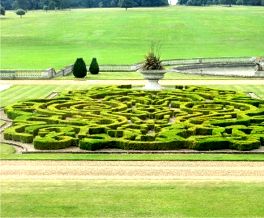
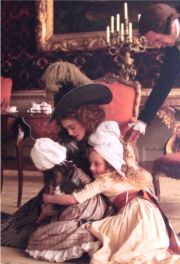
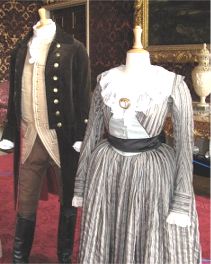
The marble topped tables are particularly noteworthy having mosaic marble tops made from mosaic pavements from excavations at Emperor Hadrian's villa near Tivoli. The tops are supported by a carved and gilded frame made in the form of giant carved birds.
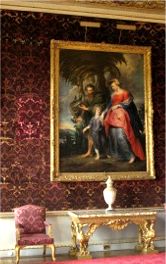
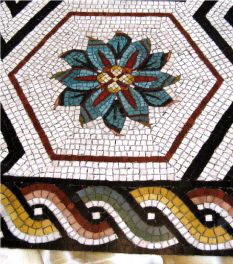
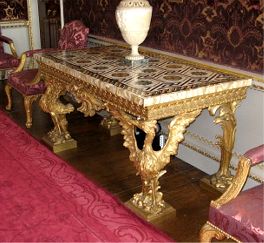
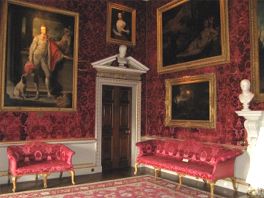
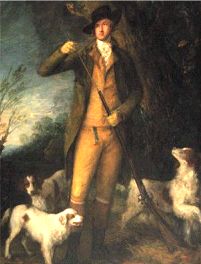 Moving
through the Saloon, brings you to the South Dinning Room. Once again, the decoration
is in similar vane to that of the previous two rooms, thus forming an elegant suite.
There is the same type of rich crimson coloured wall hangings. In the original scheme,
the South Dining Room was the State Bedchamber, housing the state bed. Over the
fireplace hangs a portrait of 'Coke of Norfolk' by Thomas Gainsborough (1727-1788),
unmistakable from his use of moving brush strokes in his paintings. Again seat furniture
in this room is arranged about the walls in 18th century fashion, being brought
into the room space as and when required.
Moving
through the Saloon, brings you to the South Dinning Room. Once again, the decoration
is in similar vane to that of the previous two rooms, thus forming an elegant suite.
There is the same type of rich crimson coloured wall hangings. In the original scheme,
the South Dining Room was the State Bedchamber, housing the state bed. Over the
fireplace hangs a portrait of 'Coke of Norfolk' by Thomas Gainsborough (1727-1788),
unmistakable from his use of moving brush strokes in his paintings. Again seat furniture
in this room is arranged about the walls in 18th century fashion, being brought
into the room space as and when required.
The final room along the South Front is The Landscape Room which as the name suggests the walls are hung entirely with landscape paintings by various Old Masters. Many of these were brought back from the Grand Tour as we today would return with postcards or photographs.
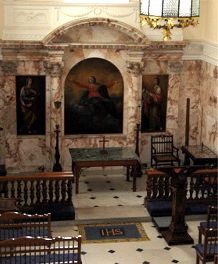
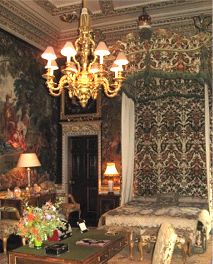 The
South East wing on this corner of the house contains The Chapel, with the piano
nobile level entering straight into the private family balcony pew. This chapel
is still used during the winter months as it is has the luxury of heating, which
the church in Holkham Park does not!
The
South East wing on this corner of the house contains The Chapel, with the piano
nobile level entering straight into the private family balcony pew. This chapel
is still used during the winter months as it is has the luxury of heating, which
the church in Holkham Park does not!
Along the East Wing of the main block of the house there are the impressive State Bedrooms comprising the Green State Bedroom, Closets, North State Bedroom and finally the North State Sitting Room which is hung with fine 17th century Brussels tapestries.
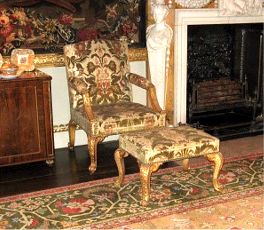
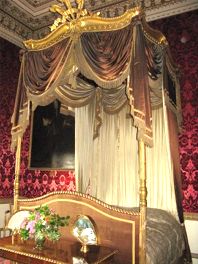
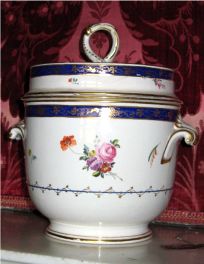
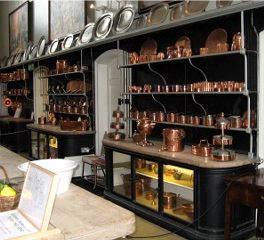
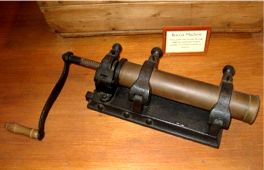 Leaving
the house through the side of the Marble Hall takes you through the old kitchen
and service wing which came into service in 1756, with an update in the 1850s. The
kitchen remained in use until the beginning of World War II. Today, it displays
many of the original cooking implements, pewter and copper plates and moulds. In
various small rooms are interesting displays depicting various domestic activities,
such as bread making, making of dairy products such as butter, cheese etc. There
is even a very curious looking biscuit maker. Adjacent to the house is the Bygones
Museum, housed in the Stable block which gives a wonderful insight into things used
in days gone by. This exhibition is a fun way to end a visit to Holkham, which in
my opinion is a house of excellent proportion and good taste.
Leaving
the house through the side of the Marble Hall takes you through the old kitchen
and service wing which came into service in 1756, with an update in the 1850s. The
kitchen remained in use until the beginning of World War II. Today, it displays
many of the original cooking implements, pewter and copper plates and moulds. In
various small rooms are interesting displays depicting various domestic activities,
such as bread making, making of dairy products such as butter, cheese etc. There
is even a very curious looking biscuit maker. Adjacent to the house is the Bygones
Museum, housed in the Stable block which gives a wonderful insight into things used
in days gone by. This exhibition is a fun way to end a visit to Holkham, which in
my opinion is a house of excellent proportion and good taste.
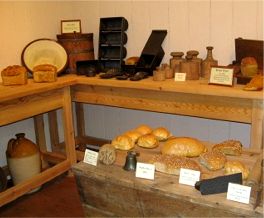
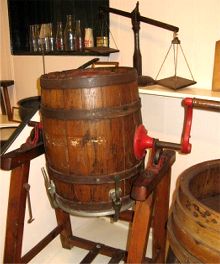
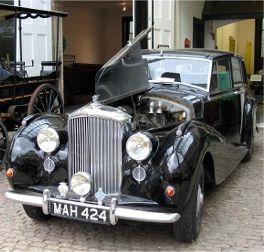
To review past newsletters, just follow this link:
Past newsletters.
To subscribe to this free newsletter -
Click here